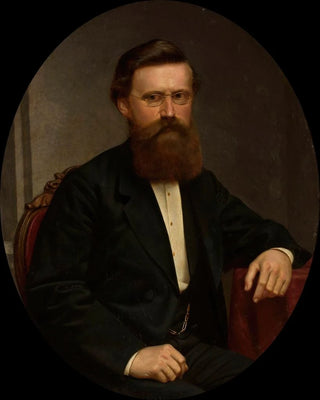Art print | Portrait of Ksawery Skrzyński - Józef Simmler


View from behind

Frame (optional)
The "Art print of Ksawery Skrzyński Portrait," created by Polish artist Józef Simmler, is a piece that transcends the simple frame of a figurative representation. This painting, which captures the essence of a man both noble and complex, invites the viewer to delve into a universe where emotion and history intertwine. Through this portrait, Simmler does not merely depict his subject; he manages to evoke an atmosphere, a period, and a psychological depth that still resonate today. The finesse of his stroke and the harmony of colors testify to exceptional craftsmanship, making this work a must-have for art enthusiasts.
Style and uniqueness of the work
Simmler’s style is distinguished by remarkable mastery of nuances and textures. In the "Art print of Ksawery Skrzyński Portrait," every detail, from the penetrating gaze of the subject to the delicacy of the drapery, contributes to creating an ambiance that is both solemn and intimate. The artist skillfully plays with light, highlighting Skrzyński’s features while maintaining a certain mystique around his personality. The colors, subtly chosen, evoke a rich and warm palette that draws the eye and captivates the mind. This art print is not limited to a simple representation; it is an invitation to explore the thoughts and emotions that inhabit its subject, thus revealing the uniqueness of the work beyond its technique.
The artist and his influence
Józef Simmler, born in Poland, is an artist whose work is part of the European Romanticism movement. Raised in a rich artistic context, he knew how to draw inspiration from great masters while developing his own voice. His approach to portraiture is marked by a desire to capture not only the external appearance of his subjects but also their inner essence. Simmler had a notable influence on his contemporaries, and his works continue to inspire many artists today. By choosing to paint historical and cultural figures, he contributed to shaping Poland’s artistic identity in the 19th century, making his portraits witnesses to a time of great change.
A decoration

Matte finish

View from behind

Frame (optional)
The "Art print of Ksawery Skrzyński Portrait," created by Polish artist Józef Simmler, is a piece that transcends the simple frame of a figurative representation. This painting, which captures the essence of a man both noble and complex, invites the viewer to delve into a universe where emotion and history intertwine. Through this portrait, Simmler does not merely depict his subject; he manages to evoke an atmosphere, a period, and a psychological depth that still resonate today. The finesse of his stroke and the harmony of colors testify to exceptional craftsmanship, making this work a must-have for art enthusiasts.
Style and uniqueness of the work
Simmler’s style is distinguished by remarkable mastery of nuances and textures. In the "Art print of Ksawery Skrzyński Portrait," every detail, from the penetrating gaze of the subject to the delicacy of the drapery, contributes to creating an ambiance that is both solemn and intimate. The artist skillfully plays with light, highlighting Skrzyński’s features while maintaining a certain mystique around his personality. The colors, subtly chosen, evoke a rich and warm palette that draws the eye and captivates the mind. This art print is not limited to a simple representation; it is an invitation to explore the thoughts and emotions that inhabit its subject, thus revealing the uniqueness of the work beyond its technique.
The artist and his influence
Józef Simmler, born in Poland, is an artist whose work is part of the European Romanticism movement. Raised in a rich artistic context, he knew how to draw inspiration from great masters while developing his own voice. His approach to portraiture is marked by a desire to capture not only the external appearance of his subjects but also their inner essence. Simmler had a notable influence on his contemporaries, and his works continue to inspire many artists today. By choosing to paint historical and cultural figures, he contributed to shaping Poland’s artistic identity in the 19th century, making his portraits witnesses to a time of great change.
A decoration






